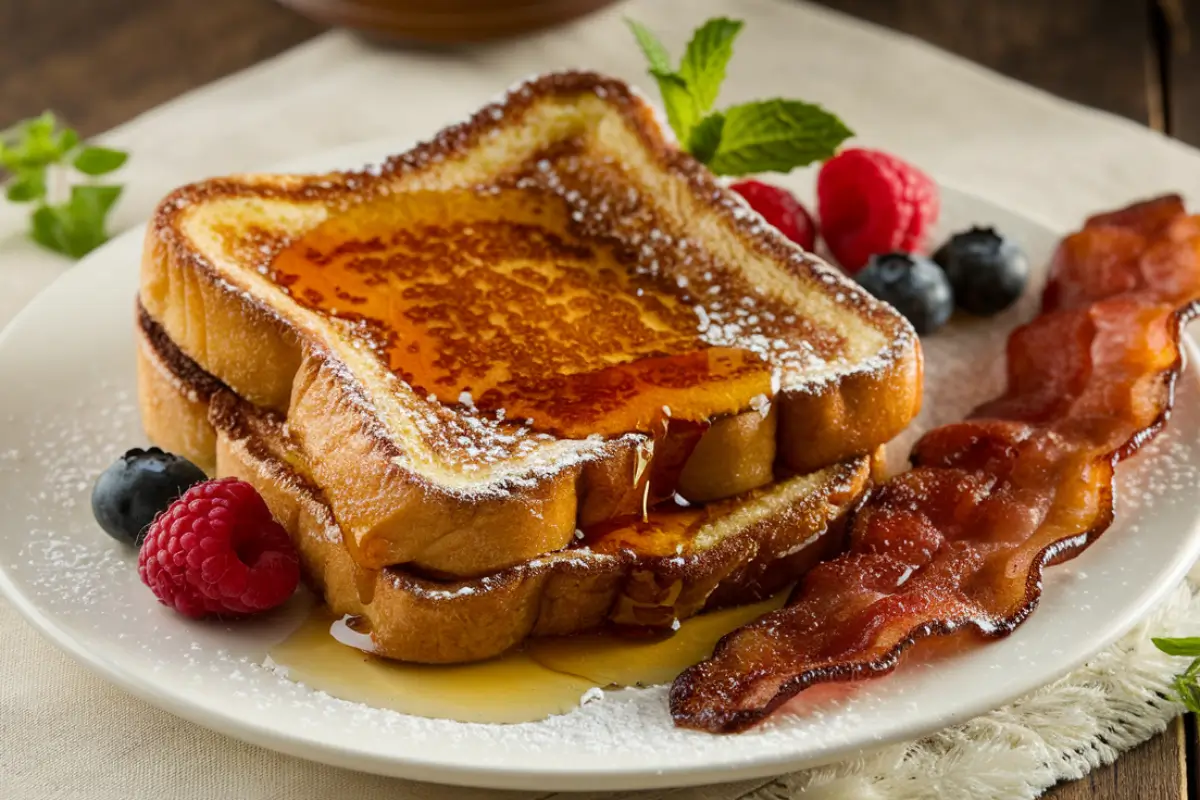A Timeless Breakfast Delight
Classic French Toast is a beloved breakfast dish known for its simple yet indulgent qualities. Made from bread soaked in a mixture of eggs and milk, then cooked to golden perfection, French toast is a versatile dish that can be enjoyed sweet or savory. This article explores the history of French toast, provides a detailed recipe, and offers tips for perfecting this classic dish.
Table of Contents
- The History of French Toast
- Why French Toast is a Breakfast Favorite
- Ingredients for Classic French Toast
- How to Make Classic French Toast
- Preparing the Bread
- Making the Egg Mixture
- Cooking the French Toast
- Tips and Variations
- Nutritional Information
- Frequently Asked Questions (FAQs)
- Conclusion
The History of French Toast
French Toast has a long and varied history. Despite its name, French toast’s origins are not actually French. The dish can be traced back to ancient Rome, where a similar recipe involved soaking bread in milk and eggs before frying. It was later adopted by French and European cuisines and became known as “pain perdu,” which means “lost bread”—a reference to using stale bread. In the 17th century, French toast made its way to America and evolved into the classic breakfast dish we know today.
Why French Toast is a Breakfast Favorite
French Toast is popular for several reasons. First, it’s incredibly easy to make, requiring only a few basic ingredients. Second, it’s highly versatile—whether you prefer it sweet with maple syrup and fruit or savory with cheese and herbs, French toast can be customized to suit your taste. Lastly, French Toast is a comforting and satisfying meal that provides a great start to the day, making it a favorite for breakfast or brunch.
Ingredients for Classic French Toast
To prepare Classic French Toast, you will need the following ingredients:
- Bread: 8 slices of thick-cut bread (e.g., brioche, challah, or Texas toast).
- Eggs: 4 large eggs.
- Milk: 1 cup (whole milk or any milk of your choice).
- Sugar: 2 tablespoons (optional, for a touch of sweetness).
- Vanilla Extract: 1 teaspoon.
- Cinnamon: 1 teaspoon (optional, for added flavor).
- Butter: 2 tablespoons, for frying.
- Salt: A pinch.
- Toppings: Maple syrup, fresh fruit, powdered sugar, or whipped cream.
How to Make Classic French Toast
Preparing the Bread
- Choose Your Bread: Use thick slices of bread for best results. Day-old or slightly stale bread works well as it soaks up the egg mixture better without becoming mushy.
- Cut the Bread: If your bread is not already sliced, cut it into 1-inch thick slices.
Making the Egg Mixture
- Whisk the Eggs: In a large bowl, whisk together the eggs until well beaten.
- Add Milk and Flavorings: Add the milk, sugar (if using), vanilla extract, cinnamon (if using), and a pinch of salt. Mix until well combined.
Cooking the French Toast
- Heat the Pan: In a large skillet or griddle, melt 1 tablespoon of butter over medium heat.
- Soak the Bread: Dip each slice of bread into the egg mixture, ensuring it’s fully coated. Let any excess drip off.
- Cook the Bread: Place the soaked bread slices onto the hot skillet. Cook for about 2-3 minutes on each side, or until golden brown and crisp. Add more butter to the skillet as needed.
- Serve Hot: Transfer the cooked French toast to a plate. Top with your favorite toppings such as maple syrup, fresh fruit, powdered sugar, or whipped cream.
Tips and Variations
- Bread Choices: Brioche, challah, or Texas toast works best due to their dense texture, which holds up well during cooking.
- Flavor Variations: Add a splash of orange juice or a pinch of nutmeg to the egg mixture for a unique twist.
- Gluten-Free Option: Use gluten-free bread and ensure that the milk and other ingredients are gluten-free.
- Make Ahead: Prepare the egg mixture ahead of time and store it in the refrigerator for up to 24 hours. You can also cook French toast in batches and keep it warm in the oven until ready to serve.
Nutritional Information
One serving of Classic French Toast (2 slices) provides approximately:
- Calories: 400 kcal
- Protein: 12g
- Fat: 20g
- Carbohydrates: 45g
- Fiber: 2g
- Sugar: 14g
These values are approximate and may vary based on specific ingredients and portion sizes.
Frequently Asked Questions (FAQs)
1. Can I use any type of bread for French Toast?
- Yes, while thick-cut bread like brioche or challah is preferred, you can use any type of bread. Just ensure it’s not too soft to hold up during cooking.
2. Can I make French Toast without eggs?
- Yes, you can use egg substitutes such as a mixture of milk and flour, or commercial egg replacers for a vegan option.
3. How can I make French Toast healthier?
- Use whole grain or low-carb bread, reduce the amount of sugar, and top with fresh fruit instead of syrup.
4. Can I freeze French Toast?
- Yes, you can freeze cooked French toast. Let it cool completely, then place slices in a single layer on a baking sheet. Once frozen, transfer to a freezer bag. Reheat in a toaster or oven before serving.
5. How do I avoid soggy French Toast?
- Use thicker slices of bread and don’t over-soak them. Also, make sure to cook over medium heat to ensure the exterior gets crispy while the interior cooks through.
6. Can I prepare French Toast batter ahead of time?
- Yes, you can prepare the egg mixture and store it in the refrigerator for up to 24 hours. Shake or stir well before using.
7. What are some good toppings for French Toast?
- Popular toppings include maple syrup, fresh berries, bananas, powdered sugar, whipped cream, or a drizzle of honey.
8. How do I make French Toast crispy?
- Ensure your pan is hot before adding the bread and use enough butter to create a crispy crust. Cooking over medium heat also helps to achieve the right texture.
Conclusion
Classic French Toast is a simple yet delightful breakfast dish that brings a touch of indulgence to your morning routine. With its rich history and versatile nature, it’s no wonder French toast remains a favorite for many. Whether you prefer it sweet or savory, this recipe is sure to please and provide a satisfying start to your day.


